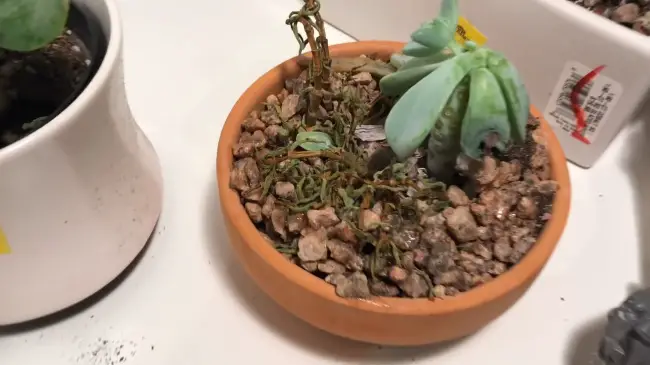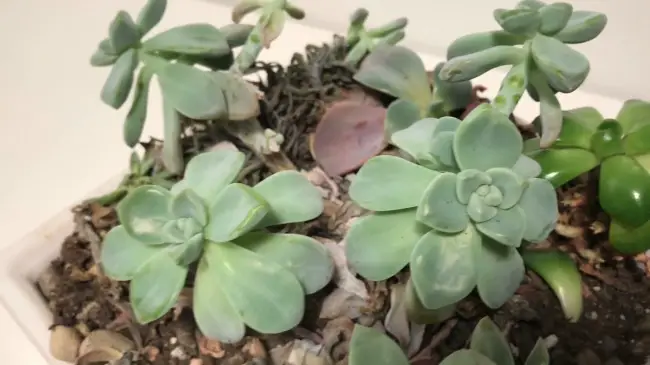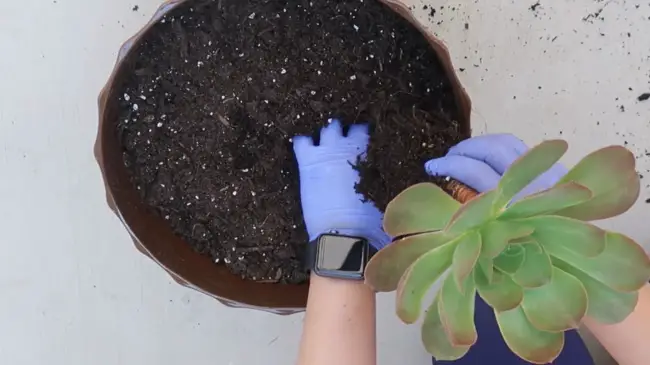Are your succulents looking a bit limp and lifeless? It’s surprisingly easy to take them from drab to fab if you know how! Succulents are hardy plants that can survive in the harshest climates, but even they need some care and attention. If yours have seen better days, don’t despair – I’m here to help you revive them with minimal effort. You’ll soon be admiring their vibrant colors once more!
By following my advice, not only will you save money by avoiding buying new ones, but also feel great knowing you’ve come through for these innocent little plants. Plus, there’s something incredibly satisfying about turning something seemingly dead back into life。
This guide is tailored towards beginner gardeners who may not have a lot of experience with plants or gardening tools. Don’t worry if you’re nervous about caring for your succulents; I’m here every step of the way to make sure everything goes smoothly.
Why Are Your Succulents Dying?
It is not very uncommon for people to have some problems and issues with their succulents. Everybody may have some succulents that they don’t really know how to take care of, and they start dying without proper care.
Some are worried because the leaves of their plants start turning brown, black, yellow, and other colors. They are keen to find out what they should do to save their plants.
So right now, I’m going to show you some examples of some common mistakes that everyone at some point probably does in their life, and I’m going to tell you what you can do with those dying succulents.
Pest Issue
I had two topsy turvy, and one of them died off because of natural death, and it left off its little bloomers and everything. I don’t want to throw it away because I like to keep it. Also, one of my ovaries is curling, and I’m not sure why it is curling in the first place. Then only I figured out it was because of the spiderweb built underneath the leaves that caused the issue.
Besides, some other common pests are snails and beetle, which can cause dark patches on the leaves. Therefore, if you want to prevent your succulent from dying, you need to observe them every day. If you see a spider or any other pests underneath it, you need to get rid of them, or they may cause curling of the leaves.
Watering Issue
Some succulents are prone to brown marks, and blotches may show up due to inconsistent watering. It is not serious, but its unsightly blisters form on leaves in the skin. You need to carry out the damage check to make sure they are not overwatering or underwatering.
Fungal Diseases
For succulents planted on a steep slope, you will be channeling the runoff and not letting it puddle in any of the areas where my succulents are growing because what happens is when water settles, those puddles, fungal diseases, and microbes will enter into the plant.
They will eat the roots of the plant. You may wonder what’s wrong with your plant because it loses its sheen, and the leaves start to fall off. Any kind of fungal disease easily compromises succulents. Their roots will drown, and then you will get the rotten squishy core of El Nino. I never lost my Ionians because they were in a low-lying area. If this happens to you, what should you do?
Dropping Leaves
Some plants drop leaves as a normal part of their lifecycle. Some shed them in winter, so they have less foliage to maintain during the lower light levels.
If your plant is dropping more leaves than it should, there could be a few reasons behind it. It could be the shock of it being delivered to your cozy home or moved to a new spot. A dip in brightness levels can also cause a plant to lose leaves because it needs to be more efficient. If a plant is outgrowing its pot, it might drop leaves because it can’t maintain all the new ones it’s trying to grow.
So if you see the roots bubbling up into the surface of the soil or coming out at the bottom of its plastic pots, it might be time for you to repot it.
Both underwatering and overwatering can cause leaves to fall off too because too much or too little moisture affects the structure of a plant. If your succulent stem rot or the leaves become yellowing and mushy, especially if it starts at the bottom of the plant, then you’re definitely overwatering. If they’re dry and curling, then it hasn’t had enough water.
When To Revive A Succulent
It’s a jungle out there when it comes to succulent care. With so many different types of plants, it can be hard to know when you need to take action and revive an ailing plant. To figure this out, we have to understand the signs that your succulents are giving off—and act quickly before it’s too late!
The first sign of distress is usually a change in color or texture. Succulents that are dying from lack of water will start to wilt and their leaves may turn yellowish-brown or soft. Meanwhile, if they’re receiving too much water, their leaves might become mushy, discolored, and rot away at the base. These changes should serve as a red flag: time to intervene!
In some cases though, the damage can be less visible but just as severe; for instance, roots being overwatered can lead to root rot which could ultimately kill the entire plant over time. So even if everything looks okay on the surface level, make sure to dig around and check the status of those deep down roots every once in a while—you never know what lies beneath!
What Can You Do To Revive The Plant?
Most of the time, when the succulents are starting to die, the trunks may get squishy so that you could squeeze them, and it was just mush. You may just cut above the rotted area and replanted the cuttings. That’s what you do after it’s too late.
Plant high on well-drained soil
Next time, You will need to remember to plant high on well-drained soil. Make sure that those plants that are most likely to rot are getting superb drainage.
The fatter the succulent, the higher it should go because the more likely it is to be prone to rot. It stores more water; therefore, it needs less watering. And its roots don’t know what to do with it when it got too much water. So your fat cacti or fat succulents should go higher on the berm.
Succulents grow well in tropical areas. You can see them all over Hawaii. The water drains right through that crushed lava rock. The roots are constantly being washed, so the fungal disease just has no room to set in.
Cut off Its Head
If your succulents start dying, you will need to cut off its head and start a new plant. That’s what you should do if most of those leaves have turned bad except for the top ones.
If you remove the leaves and see the stem, you may get some clues about whether they look wet or dry. You probably need to increase the soil level.
You may find a ruby blush and some burnt leaves, and you will need to remove them. You can root them and leave them in some dry soil. It’s good enough for them that they will start rooting.
How To Revive A Succulent Dying From Overwatering
It’s easy to overwater succulents, especially when they’re just starting out. But the results can be disastrous. Fortunately, it is possible to revive a dying succulent if you take swift action and follow these steps:
- Remove the plant from its pot and inspect its roots for rot or discoloration. If any of the roots have turned mushy or blackened, trim them away with sterilized scissors or shears.
- Place the remaining healthy root system in fresh soil that is well-draining and allows air circulation around the roots. Repotting in this way will help encourage new growth on the surviving bits of the root system left behind after pruning off the rotting parts.
- Water only sparingly going forward—you want to keep your succulent’s soil lightly moist but not wet at all times; this means watering only every week or two during dormancy (winter months) and once every few days during active growing seasons. Make sure your succulent is receiving plenty of indirect sunlight each day as well!
These tips should help bring life back into an overwatered succulent quickly and effectively–but don’t forget, prevention is still key! Taking care to research how often a particular species needs watering before getting started goes a long way toward avoiding such issues altogether.
How To Revive A Succulent Dying From Underwatering
Underwatering a succulent can be just as bad for it as overwatering. When your plant is not given enough water, the leaves will start to curl inwards and become dry and brittle. If left unchecked, this problem could eventually lead to the death of the succulent. Fortunately, with some simple steps, you can revive your underwatered succulent!
The first step is to make sure that you are only giving the succulent an appropriate amount of water based on its needs. A good rule of thumb is to wait until the soil has completely dried out before watering again. This ensures that you don’t accidentally give too much or too little water at once. Additionally, it’s important to make sure that any excess water drains away quickly so that your plant doesn’t become soggy or root-bound.
Once you have established a regular watering schedule for your succulent, it’s time to take action on reviving it from its drying state. Start by lightly misting the leaves with warm water—this helps hydrate them without drowning them in liquid like when watered directly into the soil.
You may also want to add some fertilizer if needed; use one specifically designed for plants such as cacti and succulents as they tend to need less nitrogen than other varieties of plants do. Then let the soil dry out completely before adding more water or fertilization again.
How To Revive A Succulent Dying From Leaf Burn
If you have a succulent that appears to be dying from leaf burn, don’t worry. It’s not too late for your plant. Succulents are resilient and can recover quickly with some basic care.
The first step is to assess the damage. Leaf burn happens when the leaves of a succulent receive too much direct sunlight or heat. The affected leaves will turn yellow, brown, or black in color and may become papery thin. If only a few leaves are affected, carefully pluck them off the stem at their base using scissors or tweezers. If more than half of the leaves are burnt, it might be best to remove all of them so that new growth can take place without crowding out other healthy plants.
Next, move your succulent to an area where it won’t get direct sun or high temperatures during its recovery period—typically four weeks if no additional burning occurs. During this time, water sparingly; once every 7-10 days should suffice since overwatering can also cause leaf burn on succulents.
Make sure that any excess moisture drains away from the roots properly by providing good drainage materials like gravel or sand underneath each potting container containing a succulent plant. Finally, keep an eye out for signs of new growth—a sure sign your plant is making a comeback.
How To Revive Dying Succulents Turning Yellow, Brown, Or Black
When reviving dying succulents that are turning yellow, brown, or black, the first step is to identify the cause of their distress. Many times it’s due to underwatering; however, overwatering can also lead to root rot and other diseases. Check for signs of insect problems like scale insects or mealybugs. A soil test may tell you if there’s a nutrient deficiency as well.
Once you’ve identified the problem, take steps to correct it depending on what caused it in the first place. For example, if your succulent was over-watered and has root rot, allow it to dry out completely before watering again. If there’s an issue with pests, use an appropriate pesticide or insecticidal soap – but make sure to thoroughly read product labels so you know exactly how and when to apply them safely.
It’s important not to give up hope on ailing succulents – sometimes they just need some TLC (tender loving care) to get back into shape. Prune off dead leaves and stems then provide bright light and adequate air circulation around the plant. Feeding your succulent with a fertilizer specifically designed for cacti & succulents every few months will help strengthen its roots too. With time and proper care, many wilting plants can be revived from near death.
How To Revive Dying Succulent Leaves Shriveling, Wilting Or Wrinkled
If you’ve noticed your succulent leaves are shriveling, wilting, or wrinkled, it’s likely they’re suffering from a lack of water. Luckily, reviving them isn’t too difficult if you act quickly. Here’s what to do:
Provide the plant with sufficient hydration:
- Water deeply and thoroughly when the soil is dry in order to rehydrate the entire root system.
- Make sure the container has plenty of good drainages so that the roots don’t become oversaturated.
- Check for signs of overwatering such as yellowing or soft spots on leaves which can indicate root rot.
Give the plant some sunshine:
- Place in an area where it will get at least six hours of direct sunlight each day.
- If possible, move it outside during warm weather months and bring it indoors during cold weather months.
Feed your succulent once every two weeks with a specially formulated fertilizer designed specifically for cacti and succulents to ensure optimal growth and health.
This simple care routine should help revive your dying succulent and prevent future problems from occurring. With patience and dedication, you’ll be able to restore its vibrant beauty in no time.
How To Revive A Succulent Dying From Pests
It is estimated that 70 percent of plants die due to pest infestations, such as mealybugs and scale insects. If your succulent is suffering from a pest infestation, it’s important to take action immediately. The first step in reviving your dying succulent is to identify the cause of death. Once you’ve identified what type of pests are attacking your plant, you can start taking steps to treat them.
The next step is to create an environment that will discourage further infestation. This includes making sure there is adequate air circulation around your succulent, keeping its leaves and stems free of debris, and ensuring that it receives enough light. Additionally, it’s always a good idea to keep the soil damp but not over-watered so that pests have less opportunity to reproduce.
If necessary, use an insecticidal soap or neem oil spray on the affected area of the succulent. Make sure to follow all instructions carefully when applying these products. Also, be aware that pesticides may harm beneficial insects like ladybugs or lacewings – so only apply them if absolutely necessary. With proper care and attention, you should be able to revive a dying succulent caused by pests quickly and effectively.
How To Revie Succulent Plants From Cold?
I’m sure many of you do have problems with your succulents, cacti, agave, or sedum that got frozen during winter. Many of us have the same problem with those succulents and don’t know what we should do to revive the plants.
You may be wondering will those plants sprout back from the roots. Well, it’s a challenging question with our succulents and cacti. I have never seen them respring from the roots, but if you can salvage at least a pad or two from the top growth, you can revive the plant and regrow them again.
You need to cut the pad very carefully away from the rest of the plant and then set that piece out to air dry in a hot place but not in the bright sun for a few days.
You want that cut in to heal over, so it doesn’t leak out the plant. Then you can restart that pad. It would help if you planted it in a small container of very fine aggregate rock and sand. Get it ready, then transplant it into the garden.
You may notice some white areas that frostbite and burn. Those leaves will eventually turn brown and maybe mushy. Those leaves will die, and you should clean off the mushy dead portion but leave the heart. If they are undamaged and the roots of this plant may produce propagules or pups that you can then transplant if you want to.
The sedum is often died to the ground and then does return from its roots. In fact, you may already see new growth in these plants. Patients will be required for you as it will take them quite a long time to grow back to the size that you may have had them.
Should you pull dead leaves off succulents?
If the leaves are dead, you can remove them from the plant. While for some succulents, the leaves tend to die at the bottom part. For these types of succulents, you may leave the dying leaves there as they may wither themselves and become compost that provides the necessary fertilizer to the plant.
Succulent Dying After Repotting or Transplant
Some people are having their succulents die after they repot or transplant them. Do they just wonder why this happens?
Well, when doing repotting or transplanting, there is something that we need to take into consideration.
The first thing you need to bear in mind is don’t repot your succulents on the same day that you watered them. The best time to repot them is about 6 to 8 days after watering. This is because, during this period, the succulent is busy absorbing water in the soil. If you repot your succulent on the same day after watering, your succulent may be dying after the transplant.
Also, you will want to avoid watering your succulents right after you repot them. Your succulent will need time to suit itself in the new pot, and you should leave it as it is after transplant for 6 to 8 days. If you water it right after repotting when it is in a non-thirsty state, it may also cause the succulent to die.
How To Revive Succulents From Other Causes
Succulents are resilient plants, but still, need a bit of help when something goes wrong. As such, it’s important to know how to revive succulents from other causes. Here is what you can do:
1. Pay attention to the environment. Many times, environmental issues like too much direct sunlight or not enough humidity cause succulents to become unhealthy and weak. Check for signs that the plant isn’t getting enough water or sunlight, then adjust accordingly to create a better growing environment.
2. Trim away damaged leaves or stems if needed. If parts of your succulent have been broken off due to an accident, trim them back so they don’t spread any further damage throughout the plant. This will also help boost new growth in those areas as well.
3. Make sure you’re watering correctly. Overwatering is one of the most common mistakes made with succulents – make sure you check soil moisture levels before watering again. Too little water will dehydrate them while too much water can lead to root rot and eventual death of the plant altogether.
To sum up, reviving dying succulents requires careful observation and maintenance; pay attention to their environment and ensure proper hydration habits for optimal health and longevity.
Did you find this post useful? Would you like to get back to it later? Save THIS PIN below to your gardening or succulent board on Pinterest! 🙂




